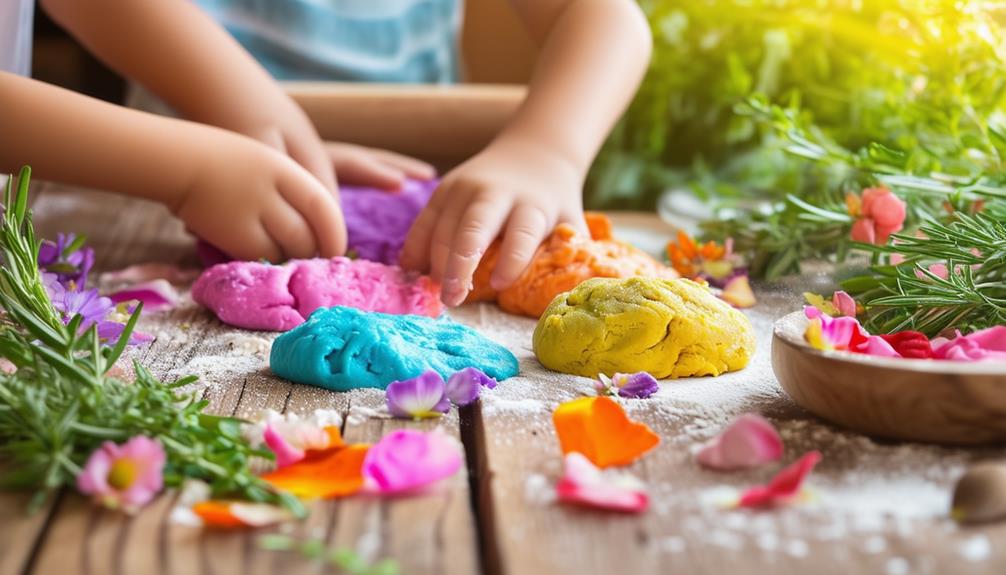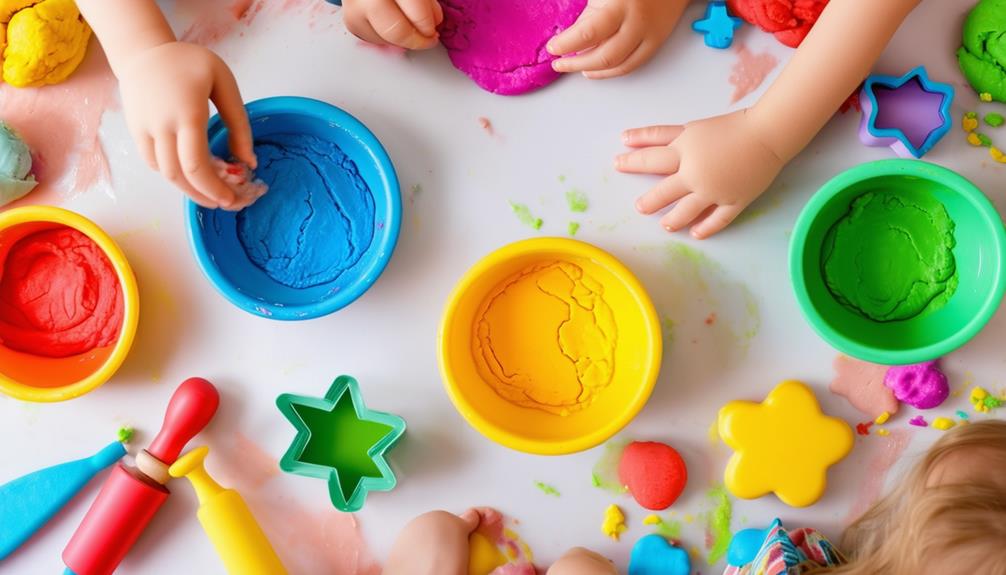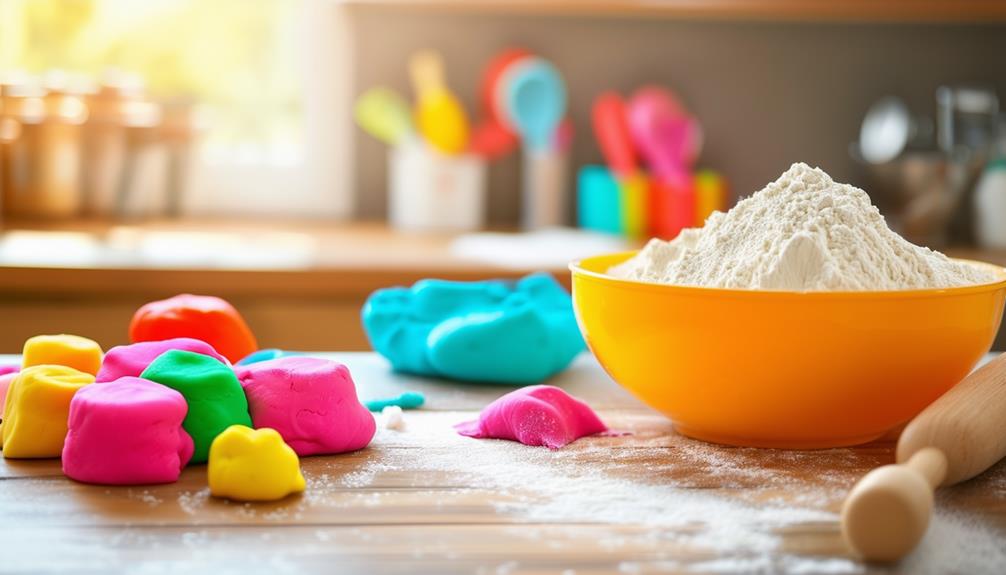Eco-Friendly Playdough: Safe and Natural Recipes

When you think about playdough, you probably picture a fun, squishy material that keeps kids entertained for hours. But have you considered the benefits of making your own eco-friendly version? Using simple ingredients like flour, salt, and natural dyes from fruits and vegetables, you can create a safe, non-toxic alternative to store-bought options. This not only protects your children from harmful chemicals but also provides an excellent hands-on educational activity. Curious about how to get started and what supplies you'll need? Let's explore the key components together.
Ingredients and Supplies
To make eco-friendly playdough, you'll need a few basic ingredients and supplies. Start with flour, which forms the base of your playdough. Mix it with water to create the dough's consistency. You'll also need salt and cream of tartar, which help preserve the playdough and improve its texture. For vibrant colors, use natural food coloring. Aromatic oils, such as those from Doterra or Young Living, can be added for a pleasant scent and sensory enrichment.
Gather your supplies: mixing bowls, saucepans, stirring spoons, and measuring cups. These tools will help you combine and cook the ingredients. It's crucial to have airtight containers on hand for storing your finished playdough, ensuring it stays fresh and pliable for future use.
Combine your flour, salt, and cream of tartar in a mixing bowl. Gradually add water while stirring to achieve the desired dough consistency. Once mixed, heat the mixture in a saucepan until it thickens. Remove from heat, let it cool, then add your natural food coloring and a few drops of aromatic oils. Store the playdough in your airtight containers to keep it fresh and ready for play.
Natural Dye Options
Creating natural dyes for your eco-friendly playdough is simple and rewarding. You can use vegetables like beets to achieve a pink hue or spices like turmeric for a vibrant yellow. To extract the colors, boil or simmer these ingredients in water. Experiment with various natural sources to discover the perfect shades for your homemade playdough.
Vegetable-Based Color Sources
Create vibrant, eco-friendly playdough colors using natural dyes from boiled vegetables or fruits. Start by selecting your natural food coloring sources, such as beets, purple cabbage, or turmeric. To prepare the dye, boil the chosen vegetables or fruits in filtered water for about 10 minutes, then simmer the mixture for another 10-30 minutes, depending on the desired color intensity.
For instance, beets can produce an intense pink hue, while purple cabbage results in a lighter pink. If you prefer a bright yellow or orange shade, turmeric dissolved in warm water makes an excellent dye.
These vegetable-based colors are not only safe but also add a unique touch to your playdough. Using natural dyes ensures your playdough is free from harmful chemicals, making it safer for children and the environment. Additionally, the process of creating these colors can be an engaging and educational activity, teaching kids about natural food sources and their uses beyond consumption. Enjoy the vibrant, eco-friendly colors of your homemade playdough!
DIY Natural Dye Process
Now that you've gathered your vegetable-based color sources, let's explore the step-by-step process of creating your own natural dyes. Start by boiling your selected vegetables or fruits in filtered water. For vibrant pinks, use beets, and for a light pink shade, choose purple cabbage. Boil these in filtered water for about 10 minutes to extract the initial color.
Next, reduce the heat and let the mixture simmer for an additional 10 to 30 minutes. This step is crucial as it allows you to achieve the desired color intensity for your natural dyes. Monitor the color development and adjust the simmering time accordingly.
For vibrant yellow or orange tones, dissolve turmeric in warm water. Turmeric is a potent natural dye that doesn't require boiling. Simply mix the spice into the water and stir until completely dissolved.
Once you're satisfied with the color intensity, strain the liquid to remove any vegetable or spice residues. Your natural dyes are now ready for use. These homemade dyes are not only environmentally friendly but also safe for making various colorful, non-toxic projects such as playdough.
Step-by-Step Instructions

Let's get started on making your eco-friendly playdough. First, gather your natural ingredients and follow the steps to prepare both the dough and vibrant natural dyes. Finally, we'll cover how to store your playdough to keep it fresh and ready for play.
Ingredients and Preparation
To create eco-friendly playdough, gather the following ingredients: 2 cups of flour, 1/2 cup of salt, 2 tablespoons of cream of tartar, 2 tablespoons of oil, natural food coloring, and 1 cup of water. Start by mixing the dry ingredients in a large bowl. This forms the base for your playdough, providing a smooth and pliable texture that kids will enjoy.
Next, combine the water with a few drops of natural food coloring and the oil. Pour this liquid mixture into the bowl of dry ingredients and stir until a dough begins to form. The oil makes the playdough soft and easy to mold, while the food coloring adds a fun element.
Transfer the dough to a medium saucepan and cook over low heat, stirring continuously. After a few minutes, the dough will thicken and pull away from the sides of the pan. When it is no longer sticky, remove it from the heat. Knead the dough on a clean surface until smooth. Your eco-friendly playdough is now ready for hours of play!
Coloring and Storage
After kneading your playdough to a smooth consistency, enhance the experience by adding vibrant colors using natural dyes. Boil vegetables or fruits like beets for intense pink and turmeric for bright yellow/orange in filtered water. Simmer them for 10-30 minutes to attain the desired color intensity. Alternatively, dissolve spices in warm water for quick, natural hues.
Mix the colored water with your playdough ingredients: flour, salt, cream of tartar, and olive oil. Cook the mixture until a dough forms, then knead it until it's smooth. For those with sensitivities, a gluten-free version using rice flour and cornstarch or arrowroot is a fantastic option. Adding essential oils can enhance the sensory experience with pleasant fragrances.
Store your non-toxic playdough in an airtight container to keep it fresh and pliable for future use. Keep each color in separate containers to avoid mixing. By following these steps, you can create different colors of safe, eco-friendly playdough for hours of creative fun.
| Natural Dye Source | Resulting Color |
|---|---|
| Beets | Intense Pink |
| Turmeric | Bright Yellow/Orange |
| Spinach | Green |
| Blueberries | Purple/Blue |
| Carrots | Orange |
These simple steps ensure your playdough remains vibrant and enjoyable!
Playdough Toys and Tools
When playing with environmentally friendly playdough, incorporating safe and high-quality toys like the Green Toys Playdough Vital Toys Set and Mirus Toys Wood Playdough Stamps can significantly enhance the experience. These playdough toys are ideal for children at home, providing an opportunity for immersive craft projects that ignite their creativity. Ensuring the use of safe playdough and tools designed for creative play guarantees your child's safety while they explore various colors and shapes.
To further enrich their playtime, consider adding these essential tools:
- A butter knife for precise cutting and shaping.
- A rolling pin for flattening the playdough.
- Stainless steel cookie cutters in fun and engaging shapes.
- A glass cutting board to maintain a clean play area.
These tools can elevate simple playdough sessions into intricate craft projects. By offering a range of colors and textures, you can inspire children to develop their creativity and fine motor skills. The right playdough toys and tools are crucial in transforming a basic activity into an engaging and educational experience. So, gather your safe playdough, select some handy tools, and let your children's imaginations explore endless possibilities!
Storage Tips

Proper storage of eco-friendly playdough ensures it remains fresh and ready for your child's next creative session. Always use airtight containers to store natural playdough, as these prevent it from drying out and maintain its soft, pliable texture. If you don't have airtight containers, Ziplock bags or reusable silicone bags are excellent alternatives because they seal tightly, keeping the playdough fresh and protected from air exposure.
Proper storage not only maintains texture but also prevents mold and mustiness. Always let the playdough cool completely before storing it. This step is crucial for preserving both the texture and quality, ensuring it's safe and enjoyable for future use.
Sometimes, even with the best storage practices, playdough can dry out. If this happens, you can easily revive it by kneading in a few drops of vegetable or canola oil. This simple trick restores its softness and makes it fun to play with again.
Reader Feedback
Hearing from our readers about their experiences with eco-friendly playdough is both inspiring and insightful. Many of you have shared heartwarming stories, useful tips, and creative ideas in the comments section. Here's a glimpse of what our vibrant community has to say:
- Gratitude for Recipes: Many readers express their thanks for providing safe, non-toxic alternatives to store-bought playdough.
- Interest in Natural Dyes: There's a lot of excitement about experimenting with plant-based colors and natural dyes.
- Questions about Ingredients and Tools: Our readers often ask where to find specific tools or ingredients, with many identifying them through affiliate links.
- Personal Experiences: Some of you have shared your use of essential oils, adding unique scents to your homemade playdough.
You've also shown a keen interest in the cost-effectiveness and safety provided by these natural recipes, which is especially significant for your children. As an Amazon Associate, we earn from qualifying purchases, and we love that our recommendations help you find what you need. Please remember that mandatory fields are marked when you leave a comment, so we can continue this meaningful exchange. Don't forget to save your name, email, and website for the next time you comment!




